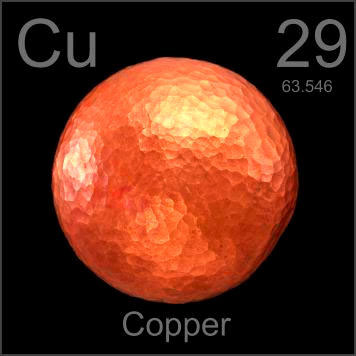Author: Rick Malter Ph.D. is the author of The Strands of Health: A Guide to Understanding Hair Mineral Analysis. He is the founder of The Malter Institute
Copper Excess: Low Energy and Chronic Fatigue
Copper is an essential nutrient mineral, but it is only needed in small quantities. Too much copper can be as much of a health problem as too little copper. However, over the past 30 years, excess copper or copper toxicity has become so common that it has affected the physical and psychological functioning of large numbers of people, especially teen-age girls and women.
Contents
- Understanding the Health Effects of Excess Copper
- Sources of Excess Copper
- Copper Increases Over Generations
- Elimination of Excess Copper
- Screening and Safe Elimination
- References

Copper is an example of a heavy metal that's a nutrient at low concentrations but extremely toxic at higher levels. Your body uses copper for bone growth, nerve conduction, hormone secretion and more; yet in excess, and especially in non-organically bound form, copper has been linked to oxidative stress and brain damage that may lead to cognitive decline and Alzheimer's disease. A 2013 study found that exposure to even trace amounts of copper in drinking water (levels one-tenth of US Environmental Protection Agency water quality standards for copper) may increase the risk of Alzheimer's.
Understanding the Health Effects of Excess Copper
I believe that it is virtually impossible to understand what has happened to the psychological and physical health of large numbers of people unless you have an awareness of this problem of copper excess in cells and tissues. In a 1987 article, Dr. Carl Pfeiffer discussed the problem of excess copper as it relates to many different physical and psychological problems. Among the psychological problems are hyperactivity, concentration and memory problems, schizophrenia, depression (including postpartum depression), anxiety and panic attacks, and violent outbursts. Addictions may also intensify with excess copper in some people. Many individuals with excess copper experience a lack of feeling or emotional "numbness." On a physical level, excess copper is associated with hypothyroidism, constipation, fatigue and exhaustion, cold hands and feet, and a weakened immune system with special susceptibility to viral and yeast infections. The premenstrual syndrome also is frequently associated with excess copper.
It is difficult for many people, including health care professionals, to imagine that an excess of one single nutrient mineral can affect so many aspects of both physical and psychological health. It is indeed the case with excess copper. This may be easier to understand when we consider the fact that excess copper stores in the liver and in the brain. Therefore, excess copper can affect both physical and psychological functions.
Sources of Excess Copper
The major sources of excess copper are:
- Copper water pipes, especially when attached to a water softening system.
- Copper IUD's.
- Oral contraceptives with their estrogen content.
The latter two methods of birth control appear to have had a major effect in elevating the tissue copper levels of large numbers of teen girls and women since the end of World War II. High copper levels are very commonly seen in hair TMA profiles of many teen girls and women today.
Another important factor affecting tissue copper levels is stress. This is because zinc is necessary to balance copper levels in the body. Under stress, large amounts of zinc and magnesium are lost from the body's cell and tissue stores. With less zinc available, elevated copper levels have a more toxic effect psychologically and physically. Memory and concentration problems increase and are frequently accompanied by a loss of emotional control. Physically, inflammatory conditions are exacerbated. Increased water retention is common. There may also be an exacerbation of blood sugar problems.
As copper increases in the body, potassium levels will be lowered and calcium levels will increase. This shift has a tendency to slow the activity of the thyroid gland. With the lowering of the potassium, the Na/K ratio will increase, thereby putting the individual in a more chronic "fight" or "flight" response. Sodium may increase with a corresponding drop in magnesium levels. Therefore, a buildup of excess copper will tend to contribute to more intense feelings of fear and anger in a person. As more and more excess copper builds up, it will lead to a shift from anger and fear to rage and terror or panic. Such intense emotion involving rage and terror or panic will leave such a person feeling "out of control." This is a very common reaction of a person with high copper.
This change in the Na/K ratio with its intense emotional reaction also inflates the Judge in a person's personality. As the Judge inflates, it will intensify the stress and emotional reactions in a vicious cycle. Psychologically, people with high copper will often feel "driven" to push themselves in a highly compulsive manner until they reach a point of total exhaustion. This phenomenon is frequently seen in exercise addicts who are very compulsive about "working out" six or seven days a week. However, they will ultimately reach a point at which they have driven themselves to exhaustion. Then, they suddenly stop working out completely. They no longer are able to psychologically drive themselves to override their underlying physical exhaustion. Then, they become exercise "dropouts." They have depleted what little energy they had and there are no more reserves upon which to draw. They have burned themselves out.
The effects of an increased copper level on hTMA mineral patterns are shown in the following two graphs. "Slow Oxidizer" graphs ( figure 1 and figure 2 below) are used for this illustration of the dynamic effects of increased copper because the effects are more easily seen, and copper increases are more common in individuals with a slow metabolic pattern.

Figure 1. Slow (metabolism) w/low copper levels.

Figure 2. Slow (metabolism) with high copper levels.
Figures 1 and 2. Note that when the copper level is low, there is usually a better balance between calcium (Ca) and magnesium (Mg). Also, there is usually a better balance between sodium (Na) and potassium (K). The disruptive effect on these delicate mineral balances is more clearly seen as copper elevates in the second graph. Both the Ca/Mg and Na/K ratios usually increase. Typical problems with a high Ca/Mg and Na/K ratio then begin to manifest. This is one of the major reasons why the birth control pill and hormone replacement therapy induce so many health problems- both physical and psychological -in the females who take these substances. Estrogen raises copper levels and triggers this significant shift in the mineral pattern. Similar effects occur with the copper IUD.
On a physical level, the increase in the Na/K ratio that occurs with a buildup of excess tissue copper will tend to result in swelling and fluid retention. Chronic inflammatory conditions may occur with the high Na/K ratio. As copper increases to excess levels in the body's tissues, calcium levels also increase, but the excess calcium tends to deposit more and more in soft tissues and joints rather than in bone and teeth. There usually is also an increase in the Ca/Mg ratio. This will contribute to increasing problems with blood sugar regulation. Sugar cravings and other addiction cravings may worsen. Also, on a physical level, as excess copper raises the level of calcium in the soft tissues, the calcium/potassium (Ca/K) ratio also increases, reflecting a slowing of thyroid gland activity. This is associated with diminished energy levels and depression.
As excess copper and calcium increase in the cells and tissues, a calcium "shell" will build up that will tend to block more and more feelings until the person no longer is aware of what is being felt and experienced. Such a person often talks of "not feeling anything" or being "numb" and "dead" emotionally. As the calcium "shell" builds, a person's perception and awareness diminish. The overall psychological effect of excess copper is a loss of emotional control and awareness accompanied by diminished feelings and numbness. This is a common defense mechanism that the mind/body uses to avoid feeling the awful impact of the Judge that is also stirred up as copper increases.
The Cumulative Toxic Copper Hypothesis
As excess copper builds up in an individual's tissues, more energy production is required in order to eliminate the accumulated excess tissue copper. However, since one of the effects of the excess copper buildup is the slowing of thyroid gland activity, the body's capacity to produce energy is diminished. Therefore, as a person becomes more and more copper toxic, the body's capacity to produce the energy necessary to eliminate the excess copper is diminished and the copper will continue to accumulate. In a female with a copper excess, her own estrogen production will contribute to larger and larger accumulations of excess copper. This trend will be exacerbated if she uses the birth control "pill" with its estrogen content or a copper IUD. During pregnancy with all of its accompanying stresses, some of the stored copper will be eliminated from tissue storage into the blood stream and some of it will find its way into the placenta and into the fetus.
This process of copper transfer from the mother to the fetus normally occurs in pregnancy, but in the case of a teen girl or a woman who starts her pregnancy with a copper excess, the amount of copper which may be transferred to the fetus is likely to be much greater than normal. Since copper antagonizes zinc, the baby may also experience a significant zinc deficiency. This may result in a lower than ideal ratio of zinc/copper. Since much excess copper is stored in the liver, high bilirubin counts may contribute to jaundice at birth. Immune system weakness, allergies, and recurring infections are commonly found in the health history of such children. The high copper in the mother may also put her at very high risk for a postpartum depression. This risk can be greatly reduced by early identification of the copper excess either before the pregnancy begins or early in the pregnancy. Zinc, vitamin C and vitamin B6 can be very effective in reducing the risk of postpartum depression associated with a high copper level.
Copper Increases Over Generations
A female child born to a mother who has a copper excess will begin life with a higher copper level than her mother began life. Throughout her developing years, such a female child is likely to accumulate more and more copper in her tissues, especially during pre-adolescence and adolescence when her own estrogen production increases. She is likely to give birth to children who will absorb higher amounts of copper than she absorbed in utero. In each succeeding generation, this cycle is likely to repeat itself resulting in more and more children born with significant copper excesses (see figure 3). This process of transmitting more and more copper in utero from one generation to the next with increasing amounts of excess copper building up and accumulating to toxic levels in each generation is likely to produce an epidemic of psychological and physical problems associated with excess tissue copper. This is primarily due to the fact that excess copper tends to be stored in the brain and in the liver.

Figure 3. Copper toxicity increases exponentially over generations.
The increasing numbers of children and adolescents who have learning and behavior problems can be partly related to the accumulation and transmission of excess copper from one generation to the next. Such a trend has very serious implications for families, schools, and society in general. The incidence rates of Learning Disabilities and Attention Deficit Disorder are likely to continue to increase as excess copper is transmitted from one generation to the next. Aggressive and violent behavior also will tend to increase with the build up of excess tissue copper levels. Addictive cravings and addictive behavior also are likely to increase. Depression and panic attacks will likely also increase in frequency.
Elimination of Excess Copper
The elimination of excess copper often occurs with significant discomfort. Many of the signs and symptoms of the premenstrual syndrome are also experienced with the elimination or "dumping" of excess stored copper. Teen girls and women who experience PMS reactions have some familiarity with what "copper dumping" feels like.
The elimination or "dumping" of excess copper requires an increase in the metabolic rate that will be associated with an increase in cellular energy production. Any process or activity that will increase the metabolic rate and cellular energy production may trigger a copper "dump" from cellular storage. Aerobic exercise, stimulant drugs, and an increase in a person's stress level all would tend to increase the metabolic rate and, therefore, result in a copper "dump". Certain vitamins and minerals also can have a stimulating effect on the metabolic rate and result in a copper "dump". The increase in metabolic rate needed to dump excess copper will also increase a person's requirement for anti-oxidants.
When copper dumping or elimination occurs without the person being aware of what is happening, this process can be very frightening and disturbing. Depending on what are the person's major symptom reactions to the copper dump, the individual may think that he or she is going crazy or having a heart attack. Suicidal depression or uncontrollable anger and rage may be felt. Anxiety and panic attacks may also occur. Sleep disturbances and the mind "racing" are not uncommon. Concentration and memory may be adversely affected. Overall, copper "dumping" is frequently experienced as a roller coaster ride.
When a person is aware of the phenomenon of excess tissue copper and the possibility of copper dumping, there usually is less fear and disturbance when it occurs. Even though copper dumping is uncomfortable and does not feel good, when it is understood, most individuals are able to cope with it when it does occur. This is especially true if the person is taking nutritional supplements to minimize the effects. Copper dumping usually occurs in cycles so that a person often feels as if she or he is on a roller coaster. When the roller coaster pattern is understood, then copper dumping is more tolerable. As more and more excess stored copper is eliminated, a person feels more energy and a greater sense of well being afterward.
It should be noted that, since excess copper is stored in the brain, it is not uncommon for a person with high copper to experience significant psychological problems stemming from the excess copper buildup in the brain. Depression, panic attacks, and obsessive-compulsive reactions are commonly associated with a brain copper buildup.
In this era of "reflex" prescription writing for anti-depressants and other psychotropic drugs, many people with high copper, especially teen-age girls and women, are given prescriptions for very powerful drugs with little or no understanding of the underlying copper excess. Many of these anti-depressants and other psychotropic drugs are highly addictive. These types of drugs can easily throw a person into what I call "biochemical chaos." That is, the person's biochemistry, especially that involving the essential nutrient minerals, is thrown into such a chaotic mess that it is very difficult to overcome. When a person tries to withdraw from any of these addicting drugs, there are often severe withdrawal reactions. The prescribing physician frequently views these withdrawal reactions as "evidence" that confirms how "sick" she really was.
It seems difficult for many physicians to imagine that an FDA approved medication could produce such biochemical chaos and actually produce worse emotional and behavioral reactions than before the prescription medication was started.
Screening and Safe Elimination
The identification and elimination of excess stored tissue copper is one of the most challenging health problems we face today. Hair Tissue Mineral Analysis (hTMA) is the most effective laboratory tool we have for identifying the underlying mineral patterns associated with excess tissue copper. hTMA also provides a guideline for selecting vitamins and minerals that are most likely going to provide the individual with the nutritional support needed to safely eliminate the excess tissue copper by optimizing energy production at a cellular level.
- Source: The Strands of Health: Understanding Hair Mineral Analysis Rick Malter, Ph.D
References
- Asterita, Mary. The Physiology of Stress with Special Reference to the Neuroendocrine System. New York, Human Sciences Press, Inc., 1985.
- Barkley, R. "A review of stimulant drug research with hyperactive children." Journal of Child Psychology and Psychiatry, 1977, 18, pp. 13 7-165.
- Barnes, Broda 0. & Lawrence Galton. Hypothyroidism: The Unsuspected Illness. New York, Harper & Row, 1976.
- Brenner, Arnold. "The effects of megadoses of selected B-complex vitamins on children with hyperkinesis: controlled studies with long term follow-up." Journal of Learning Disabilities, May, 1982, 15, pp. 258-264.
- Borysenko, Joan. Minding the Body, Mending the Mind. New York, Bantam, 1987.
- Capra, Fritjof. The Tao of Phsyics. Boulder, CO, Shambhala Publications, 1975.
- Capra, Fritjof. "The new physics: implications for psychology." The American Theosophist, Spring, 1980, pp. 114-120.
- Chopra, Deepak. Quantum Healing: Exploring the Frontiers of Mind/Body Medicine. New York, Bantam, 1989.
- Eck, Paul. Interview with Editors of Healthview Newsletter, 1981. Reprints available through Analytical Research Laboratories, Phoenix, AZ. (602) 995-1580
- Locke, Steven & Douglas Colligan. The Healer Within: The New Medicine of Mind and Body. New York, E.P. Dutton, 1986.
- Malter, Richard F. "Implications of a Bio-Nutritional Approach to the Diagnosis, Treatment, and Cost of Learning Disabilities." Paper presented at the national convention, Association for Children with Learning Disabilities, Washington, D.C., February, 1983.
- Malter, R. F. "Biofeedback and nutrition." Unpublished paper, Malter Institute for Natural Development, Inc., Schaumburg, IL, March, 1984a.
- Malter, R. F. "Copper toxicity: psychological implications for chi1dren, adolescents, and adults." Unpublished paper, Malter Institute for Natural Development, Inc., Schaumburg, IL, April, 1984b; revised, June, 2001.
- Malter, R. F. "Trace mineral profiles of hyperactive children." Unpublished paper, Malter Institute for Natural Development, Inc., Schaumburg, IL, April, 1984c.
- Malter, R. F. "Implications of a bio-nutritional approach to the d i a gnosis, treatment, and cost of Learning Disabilities." Soma tics, Autumn-Winter, 1984-85, 38-43.
- Malter, R. F. "Nutritional concerns in learning and psychological disorders." Paper presented to APA Div. 42, annual convention of the American Psychological Association, Los Angeles, CA, August, 1985a.
- Malter, R. F. "Preventing osteoporosis with calcium supplementation: possible psychological hazards." Unpublished paper, Malter Institute for Natural Development, Inc., Schaumburg, IL, August, 1985b.
- Malter, R. F. "Energy, stress, and 'bum-out': a new perspective on addictions." Unpublished paper, Malter Institute for Natural Development, Inc., Schaumburg, IL, June, 1986.
- Malter, R. F. "The concept of a health-energy continuum: implications for maintaining health." Unpublished paper, Malter Institute for Natural Development, Inc., Schaumburg, IL, Aug., 1987.
- Malter, R. F. "Zinc/copper ratios and brain function: implications for education and special education." Unpublished paper, Malter Institute for Natural Development, Inc., Schaumburg, IL, April, 1988. Reprinted in Newsletter of Trace Elements, Inc., Dallas, TX, 1988.
- Malter, R. F. "The cumulative toxic metal hypothesis and attention deficit disorders." Unpublished paper, Malter Institute for Natural Development, Inc., March, 1990.
- Malter, R. F. & Malter, R. Shrinking the Judge: Freeing the Inner Child. Education & Health Resources, Hoffman Estates, IL, 1998.
- Malter, R. F. "Trace mineral analysis and psychoneuroimmunology." Journal of Orthomolecular Medicine, 2nd quarter, 1994, Vol. 9, No.2, 79-93.
- Mason, Karl E. "A conspectus of research on copper metabolism and requirements of man." Journal of Nutrition, November, 1979.
- Mehta, S. W. & Eikum, R. "Effect of estrogen on serum and tissue levels of copper and zinc." Advances in Experimental Medicine & Biology. 258: 155-62, 1989.
- Page, Melvin. Degeneration and Regeneration. St. Petersburg Beach, FL, 1949.
- Pfeiffer, Carl. Mental and Elemental Nutrients: A Physicians Guide to Nutrition and Health Care. New Canaan: Keats, 1975.
- Pfeiffer, C. Nutrition and Mental Illness: An Orthomolecular Approach to Balancing Body Chemistry. Rochester, VT, Healing Arts Press, 1987.
- Pfeiffer, C. & Mailloux, R. "Excess copper as a factor in human diseases." Journal of Orthomolecular Medicine, 1987,2, no. 3, 171-1 82.
- Pihl R. & Parkes, M. "Hair element content in learning disabled children." Science, 1977, 198, 204-206.
- Rimland, B. & Larson, G. "Hair mineral analysis and behavior: an analysis of 51studies." Journal of Learning Disabilities, May, 1983, 16, 279-285.
- Seelig, Mildred S. "Cardiovascular consequences of magnesium deficiency and loss: pathogenesis, prevalence and manifestations.
- Magnesium and chloride loss in refractory potassium repletion." American J. of Cardiology, 63: 4G-2 1G, 1989.
- Watson, George. Nutrition and Your Mind. New York: Harper & row, 1972.
- Watts, D. L. "The nutritional relationships of copper." Journal of Orthomolecular Medicine. 4, 2, 1989.
- Watts, D. L. "Nutritional interrelationshps: minerals-vitamins-endocrines." Journal of Orthomolecular Medicine, 1990.
- Watts, D. L. "Trace elements and neuropsychological problems as reflected in tissue mineral analysis (TMA) patterns." Journal of Orthomolecular Medicine, 5, 3, 1990.
- Watts, D. L. Trace Elements and Other Essential Nutrients: Clinical Application of Tissue Mineral Analysis. Trace Elements, Inc., Dallas, Texas, 1997.